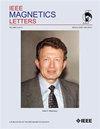用稀磁半导体制成的低势垒纳米磁体实现二元随机神经元的鲁棒性
IF 1.1
4区 物理与天体物理
Q4 ENGINEERING, ELECTRICAL & ELECTRONIC
引用次数: 5
摘要
二进制随机神经元(BSN)是机器学习的优秀硬件加速器。实现它们的一个流行平台是具有平面内磁各向异性的低能垒或零能垒纳米磁体(例如,离心率非常小的圆盘或准椭圆盘)。不幸的是,如果纳米磁体由具有大饱和磁化强度的常见金属铁磁体(Co、Ni、Fe)制成,则这种纳米磁体的横向形状的小几何变化可能会在BSN响应时间上产生大的变化。此外,响应时间对初始条件,即初始磁化方向变得非常敏感。在这封信中,我们表明,如果纳米磁体由饱和磁化强度比普通金属铁磁体小得多的稀磁半导体制成,那么它们响应时间的变化(由于形状变化和初始条件的变化)将被显著抑制。这大大减少了设备间的变化,这对大规模神经形态系统来说是一个严峻的挑战。因此,简单的材料选择可以缓解纳米磁体概率计算中最严重的问题之一。本文章由计算机程序翻译,如有差异,请以英文原文为准。
Robustness of Binary Stochastic Neurons Implemented With Low Barrier Nanomagnets Made of Dilute Magnetic Semiconductors
Binary stochastic neurons (BSNs) are excellent hardware accelerators for machine learning. A popular platform for implementing them is low- or zero-energy barrier nanomagnets possessing in-plane magnetic anisotropy (e.g., circular disks or quasi-elliptical disks with very small eccentricity). Unfortunately, small geometric variations in the lateral shapes of such nanomagnets can produce large changes in the BSN response times if the nanomagnets are made of common metallic ferromagnets (Co, Ni, Fe) with large saturation magnetization. In addition, the response times become very sensitive to initial conditions, i.e., the initial magnetization orientation. In this letter, we show that if the nanomagnets are made of dilute magnetic semiconductors with much smaller saturation magnetization than common metallic ferromagnets, then the variability in their response times (due to shape variations and variation in the initial condition) is drastically suppressed. This significantly reduces the device-to-device variation, which is a serious challenge for large-scale neuromorphic systems. A simple material choice can, therefore, alleviate one of the most aggravating problems in probabilistic computing with nanomagnets.
求助全文
通过发布文献求助,成功后即可免费获取论文全文。
去求助
来源期刊

IEEE Magnetics Letters
PHYSICS, APPLIED-
CiteScore
2.40
自引率
0.00%
发文量
37
期刊介绍:
IEEE Magnetics Letters is a peer-reviewed, archival journal covering the physics and engineering of magnetism, magnetic materials, applied magnetics, design and application of magnetic devices, bio-magnetics, magneto-electronics, and spin electronics. IEEE Magnetics Letters publishes short, scholarly articles of substantial current interest.
IEEE Magnetics Letters is a hybrid Open Access (OA) journal. For a fee, authors have the option making their articles freely available to all, including non-subscribers. OA articles are identified as Open Access.
 求助内容:
求助内容: 应助结果提醒方式:
应助结果提醒方式:


